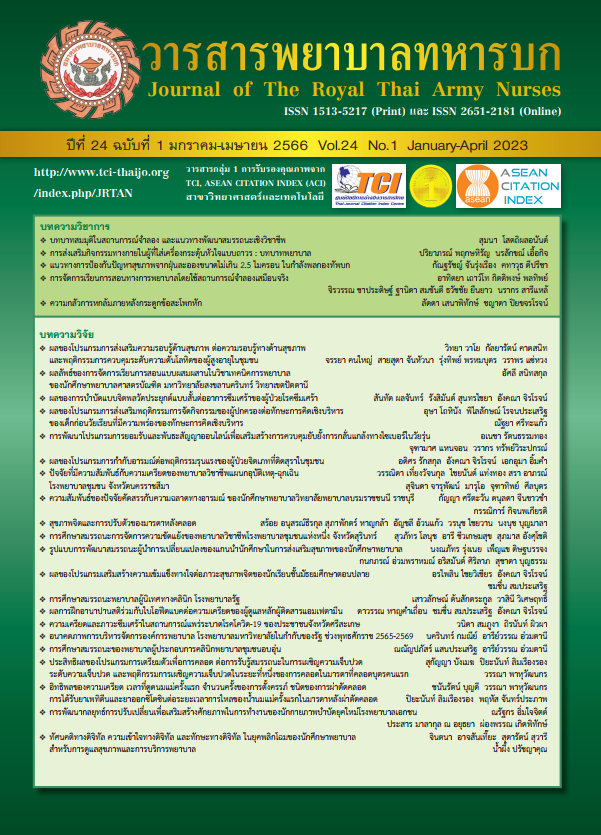ความกลัวการหกล้มภายหลังกระดูกข้อสะโพกหัก
คำสำคัญ:
ความกลัวการหกล้ม, กระดูกข้อสะโพกหัก, ผู้สูงอายุบทคัดย่อ
ความกลัวการหกล้มเป็นอาการที่มักเกิดขึ้นในผู้สูงอายุ โดยเฉพาะผู้สูงอายุหลังหกล้มกระดูกข้อสะโพกหัก ส่งผลให้สูญเสีย ความมั่นใจในการทรงตัว การเดิน และหลีกเลี่ยงการทำกิจกรรมด้วยตนเอง ซึ่งนำไปสู่การสูญเสียความสามารถในการทำกิจกรรม กล้ามเนื้อเสื่อมถอย การฟื้นฟูสภาพร่างกายภายหลังการผ่าตัดข้อสะโพกล่าช้า ทำให้เกิดภาวะซึมเศร้า มีคุณภาพชีวิตที่ลดลง ปัจจัยที่ส่งเสริมให้เกิดความกลัวการหกล้ม ประกอบด้วย ความวิตกกังวลและการรับรู้ความสามารถของตนเอง เครื่องมือที่ใช้ ในการประเมินความกลัวการหกล้ม ประกอบด้วย Falls Efficacy Scale (FES) Falls Efficacy Scale-International (FES-I) Activity-specific Balance Confidence Scale (ABC) The Survey of Activities and Fear of Falling in the Elderly (SAFE) และ Single Item Fear of Falling Question แนวทางการลดความกลัวการหกล้มในผู้สูงอายุกระดูกข้อสะโพกหักในปัจจุบัน ประกอบไปด้วย การส่งเสริมการรับรู้ความสามารถแห่งตน การบำบัดด้วยความคิดและพฤติกรรม การส่งเสริมความแข็งแรงของ กล้ามเนื้อและการทรงตัว รวมไปถึงการให้ความรู้เกี่ยวกับการป้องกันการพลัดตกหกล้มและการปฏิบัติตนเมื่อเกิดการหกล้ม พยาบาล ควรมีการประเมินและให้การพยาบาลเพื่อให้ผู้สูงอายุมีสุขภาพกายและสุขภาพใจที่ดี พึ่งพาตนเองและมีคุณภาพชีวิตที่ดีต่อไป
Downloads
เอกสารอ้างอิง
Wongsawang N, Jeenkhowkhum D, Boonsiri C, et al. Home environmenttal risk for falls and incident of falls in older adults. Veridian E-Journal Silpakorn University. 2017; 10(3): 2492-2506. (in Thai).
Nilson M, Eriksson J, Larsson B, Oden A, Johansson H, Lorentzon M. Fall risk assessment predicts fall-related injury, hip fracture, and head injury in older adults. Journal of the Amcrican Geriatvics Society. 2016;64(11): 2242-2250.
Winter A, Bradman H, Fraser C, Holt G. The management of intracapsular hip fracture. Orthopacdies & Trauma. 2016;30(2): 93-102.
Jellesmark A, Herling SF, Egerod I, Beyer N. Fear of falling and changed funtional ability following hip fracture among community-dwelling elderly people: an explanatory sequential mixed method study. Disability and Rehabilitation. 2012; 34(25): 2124-2131.
Tu CY, Shields N, Grill SD, Tacey M, Lindner C, Hill KD. Longitudinal changes in physical activity levels and fear of falling after hip fracture. Physiotherapy Research International. 2020;26(1): 1-10.
Kornfield L, Lenze EJ, Rawson KS. Predictors of posttraumatic stress symptoms and association with fear of falling after hip fracture. Journal of the Americon Geriatrics Society. 2017;65(6): 1251-1257.
Murphy J, Issacs B. The post-fall Syndrome. Gerontology. 1982;28(4): 265-270.
Phongphanngam S, Nawai A. Fall, fear of falling, and activity avoidance due to fear of falling among Thai community-dwelling older adults living in Suburban Chiang Mai Thailand. Journal of Healtn and Nursing Rescarch. 2020; 36(1): 22-38. (in Thai).
LeBouthillier DM, Thibodeau MA, Asmundson GJ. Severity of fall-based injuries, fear of falling, and activity restriction: sex differences in a population-based sample of older Canadian adults. Journal of aging and health. 2013;25(8): 1378-1387.
Tinetti ME, Richman D, Powell L. Fall efficacy as a measure of fear of falling. Journal of Gerontology. 1990; 45(6): 239-243.
Bower ES, Wetherell JL, Petkus AJ, Rawson KS, Lenze EJ. Fear of falling after hip fracture: prevalence, course, and relationship with one-year functional recovery. The Amencan J ournal of Geriatric Psychiatry. 2016;24(12): 1228-1236.
Dingova M, Kralova E. Fear of falling among community dwelling older adults. Central Europcan Journal of Nursing and Midwifery. 2017;8(1): 580-587.
Lach HW. Incidence and risk factors for developing fear of falling in older adults. Public Health Nursing. 2005;22(1): 45-52.
Kristensen MT. Factor affecting functional prognosis of patients with hip fracture. The European Journal of Physical and Rehabilitation Medicine. 2011;47(2): 257-264.
Visschedijk J, Balen RV, Hertogh C, Achterberg W. Fear of falling in patients with hip fracture: prevalence and related psychological factors. Journal of the Amcrican Medical Directors Association. 2013;14(3): 218-220.
Visschedijk HM, Caljouw AA, Balen RV, Hertogh PM, Achterberg WP. Fear of falling after hip fracture in vulnerable older persons rehabilitation in a skilled nursing facillity. Journal of Rehabilitation Medicine. 2014; 46(3): 258-263.
Painter JA, Allison L, Dhingra P, Daughtery J, Cogdill K, Trujillo LG. Fear of falling and its relationship with anxiety, depression, and activity engagement among communitydwelling older adults. The American Journal of Occupational Therapy. 2012;66(2): 169-176.
Tamsat A, Aree-Ue S, Leelacharas S. Fear of falling and functional ability in older adults undergoing hip surgery. Journal of The Police Nurses. 2015;7(1): 64-82. (in Thai)
Thiamwong L. Psychometric testing of the falls efficacy scale-international (FES-I) in Thai older adults. Songkla Medical Journal. 2011;29(6): 277-287. (in Thai)
Powell L, Myers A. The activities-specific balance confidence (ABC) scale. The Journals of Gerontology: Series A. 1995;50(1): 28-34.
Nanthapaiboon K, Wannapakhe J, Viriyatarakij N, Boonsinsukh R. Assessment of internal consistency and convergent validity of the activities-specific balance confidence (ABC) scale Thai version. Thai Pharmaceutical and Health Science Journal. 2018;13(1):1-7. (in Thai)
Lachman M, Howland J, Tennstedt S, Jette A, Assmann S, Peterson E. Fear of falling and activity restriction: the survey of activities and fear of falling in the elderly (SAFE). Journal of Gerontology: Psychological Science. 1998;53(1): 43-50.
Belloni G, Bula C, Santos-Eggimann B, Henchoz Y, Seematter-Bagnoud L. A single question as a screening tool to assess fear of falling in young-old community-dwelling persons. Journal of the American Medical Directors Association. 2020;21(9): 1295-1301.
Bandura A. Social foundation of thought and active: a social cognitive theory. Englewood Cliff, NJ: Prentice Hall; 1986
Jaipiti H, Sasat S. The effect of self-efficacy promoting program on fear of fall in postoperative total hip replacement older persons. Journal of The Royal Thai Army Nurses. 2018;19: 109-118. (in Thai)
Senarphitak L, Aree-Ue S, Youngcharoen P, Sa-Ngasoongsong P. A Tailored intervention to reduce fear of falling and improve functional ability among older adults undergoing hip surgery. Journal of The Police Nurses. 2020;12(1): 1-12. (in Thai)
Kerdpitak P. Book review the theory and practice of counselling and psychotherapy. Kasem Bundit Journal. 2012;2(1): 97-99. (in Thai)
Scheffers-Barnhoorn MN, Van Haastregt JCM, Schols JMGA. A multi-component cognitive behavioral intervention for the treatment of fear of falling after hip fracture (FIT-HIP): protocal of a randomised controlled trial. BMC Geriatrics. 2017;17(71): 1-13.
Klaus P, Karin K, Jochen K, et al. Effects of an intervention to reduce fear of falling and increase physical activity during hip and pelvic fracture rehabilitation. Age and Aging. 2020;49(5): 771-178.
Maranesi E, Riccardi GR, Lattanzio F, et al. Randomised controlled trial assessing the effect of a technology-assisted gait and balance training on mobility in older people after hip fracture: study protocol. BMJ Open. 2020;10(6): e035508-e035514.
ดาวน์โหลด
เผยแพร่แล้ว
รูปแบบการอ้างอิง
ฉบับ
ประเภทบทความ
สัญญาอนุญาต
ลิขสิทธิ์ (c) 2023 วารสารพยาบาลทหารบก

อนุญาตภายใต้เงื่อนไข Creative Commons Attribution-NonCommercial-NoDerivatives 4.0 International License.
บทความหรือข้อคิดเห็นใดใดที่ปรากฏในวารสารพยาบาลทหารบกเป็นวรรณกรรมของผู้เขียน ซึ่งบรรณาธิการหรือสมาคมพยาบาลทหารบก ไม่จำเป็นต้องเห็นด้วย
บทความที่ได้รับการตีพิมพ์เป็นลิขสิทธิ์ของวารสารพยาบาลทหารบก
The ideas and opinions expressed in the Journal of The Royal Thai Army Nurses are those of the authors and not necessarily those
of the editor or Royal Thai Army Nurses Association.







